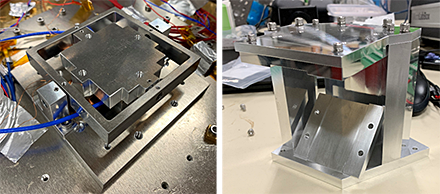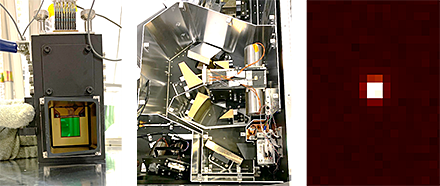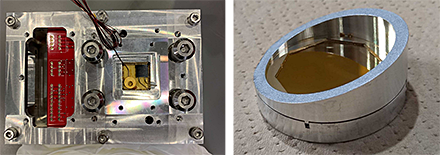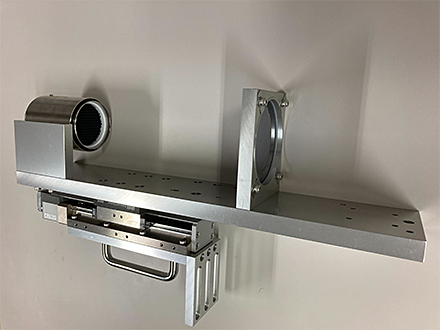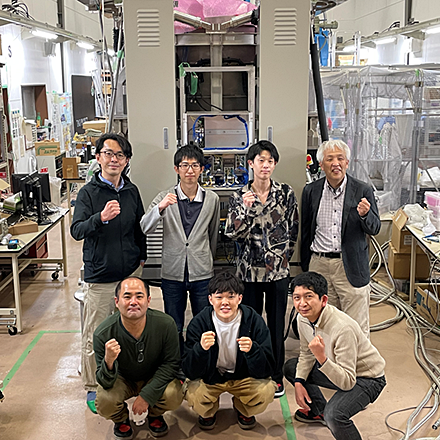
|
TAO Project |
|
The TAO project

|
Recent Progress of the Mid-Infrared Instrument MIMIZUKUMIMIZUKU is the first-generation mid-infrared instrument of the TAO telescope. It is equipped with three optical channels, NIR, MIR-S, and MIR-L, each of which covers a different wavelength range, allowing us to observe a wide wavelength range from near-infrared to long-wavelengths mid-infrared. In 2018, MIMIZUKU was mounted on the Subaru Telescope and saw the first light. But only the MIR-S channel was fully functional at that time. Therefore, we sent the instrument back to Japan to complete the NIR and MIR-L channels as well and to fix malfunctions found in the first light observation (refer to the previous ariticle). Although the planned work was largely stalled due to the spread of the COVID-19, preparations are underway for operations in Chile. In this article, we report on its recent progress. In the previous article , we described the development of a special device named cold chopper system. It is a high-speed tip-tilt mirror installed on the cold optics which is cooled to about 20 K in MIMIZUKU, and it enables high-frequency and high-speed switching of observation field of view. Subtracting the images of the two fields of view obtained using this mechanism allows us to remove background light from atmosphere etc., which is orders of magnitude stronger than the light from celestial objects, and thus enables us to detect faint celestial light. For this reason, it is indispensable for realizing observations at MIMIZUKU. Although we were only able to test its performance at room temperature in 2019, recent experiments led by Mr. Michifuji, a graduate student, confirmed its successful operation at 20 K. Based on this success, we are developing a final-product model to install on MIMIZUKU now. Mr. Michifuji completed his master's thesis on the results of this experiment and another astronomical observation study, and graduated in March 2022. The results were also presented at the SPIE2022 conference (Michifuji et al. 2022). Regarding the detector on the NIR channel for near-infrared observations (reported in our previous article), we also made a performance evaluation test mounted on MIMIZUKU (Fig. 2). It was previously uncertain whether this detector can properly detect near-infrared light. Finally, we were able to confirm that near-infrared light was properly detected with the expected sensitivity in this test. In addition, we evaluated the imaging performance, the throughput, and the spectroscopic wavelength coverage of the channel, and confirmed that the performance was generally as expected. On the other hand, some issues were found that need to be resolved, and we will work to resolve them in the future. The results of this study were presented at the SPIE2022 conference (Kamizuka et al. 2022). The remaining MIR-L channel was developed by a new member, graduate student Mr. Iida, and a wide range of development work was carried out, including evaluation of the cooling performance of the detector mount, development of the electrical circuit system for the detector, detailed study of the onboard filter to realize observation, and development of a jig to mount the filter (Fig. 3). The development of the filter-mounting jig was supported by the Advanced Technology Center of the National Astronomical Observatory of Japan, and the jig shown in Fig. 3 (right) was completed. We are going to conduct operation tests of the detector system in a test chamber, and then in MIMIZUKU. In addition, a graduate-student, Mr. Naruse, has newly joined us. MIMIZUKU aims to realize high-precision photometric observations, and to achieve this, it is important to accurately measure and correct the characteristics of individual pixels in the detector. So we decided to develop a unit that can illuminate each pixel of the detector uniformly and be mounted on MIMIZUKU. Mr. Naruse is developing this unit. He designed it as a research project as an undergraduate student, and is currently completing its fabrication and proceeding with preliminary testing (Fig. 4). The tests have shown that this unit enables more accurate correction than conventional methods, and this was also presented at the SPIE 2022 conference (Naruse et al. 2022).
With the successful contribution of the new members described above, we are accelerating the development to make up for the delays caused by the COVID-19 (Fig. 5). In the current plan, MIMIZUKU will be transported to Chile after completion of the development in Japan around the end of FY2022, and the first light observation at the TAO telescope is scheduled for FY2023 after preparation in Chile. Toward the realization of this goal, we will work together as one team to complete MIMIZUKU.
Copyright(c) 2022 TAO Project, Institute of Astronomy, Graduate School of Science, University of Tokyo
|
